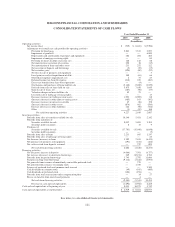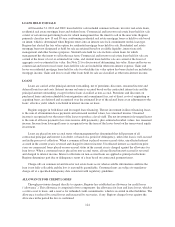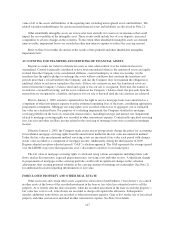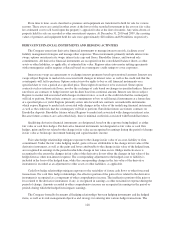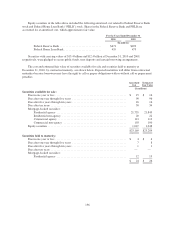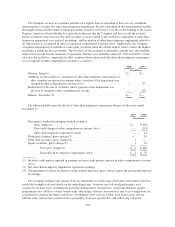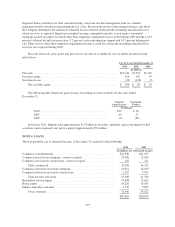Regions Bank 2010 Annual Report Download - page 144
Download and view the complete annual report
Please find page 144 of the 2010 Regions Bank annual report below. You can navigate through the pages in the report by either clicking on the pages listed below, or by using the keyword search tool below to find specific information within the annual report.Note 19 for additional discussion regarding income taxes. Income tax benefits generated from uncertain tax
positions are accounted for using the recognition and cumulative-probability measurement thresholds. Based on
the technical merits, if a tax benefit is not more-likely-than-not of being sustained upon examination, the
Company records a liability for the recognized income tax benefit. If a tax benefit is more-likely-than-not of
being sustained based on the technical merits, the Company utilizes the cumulative probability measurement and
records an income tax benefit equivalent to the largest amount of tax benefit that is greater than 50 percent likely
to be realized upon ultimate settlement with a taxing authority. The Company recognizes interest expense,
interest income and penalties related to unrecognized tax benefits within current income tax expense.
TREASURY STOCK
The purchase of the Company’s common stock is recorded at cost. At the date of retirement or subsequent
reissuance, treasury stock is reduced by the cost of such stock with differences recorded in additional paid-in
capital or retained earnings, as applicable.
SHARE-BASED PAYMENTS
Compensation cost for share-based payments is measured based on the fair value of the award, which most
commonly includes restricted stock (i.e., unvested common stock) and stock options, at the grant date and is
recognized in the consolidated financial statements on a straight-line basis over the requisite service period for
service-based awards. The fair value of restricted stock or restricted stock units is determined based on the
closing price of Regions’ common stock on the date of grant. The fair value of stock options where vesting is
based on service is estimated at the date of grant using a Black-Scholes option pricing model and related
assumptions. Expected volatility considers implied volatility from traded options on the Company’s stock and,
primarily, historical volatility of the Company’s stock. Regions considers historical data to estimate future option
exercise behavior, which is used to derive an option’s expected term. The expected term represents the period of
time that options are expected to be outstanding from the grant date. Historical data is also used to estimate future
employee attrition, which is used to calculate an expected forfeiture rate. Groups of employees that have similar
historical exercise behavior are reviewed and considered for valuation purposes. The risk-free rate is based on the
U.S. Treasury yield curve in effect at the time of grant and the weighted-average expected life of the grant.
Beginning in 2009, Regions issued restricted stock units payable solely in cash (“cash-settled RSUs”), which are
accounted for as liabilities in the consolidated balance sheets. The cash settled RSUs are subject to a vesting
period ranging from two weeks to one year and, following the vesting period, are subject to transfer restrictions
and a delayed payment, which can range from six months to two years. The grant date fair value of the award is
determined in the same manner as other restricted stock awards and is charged to the statements of operations
over the vesting period. Changes in Regions’ stock price over the delayed payment period are charged to the
statements of operations.
REVENUE RECOGNITION
The largest source of revenue for Regions is interest income. Interest income is recognized on an accrual
basis driven by nondiscretionary formulas based on written contracts, such as loan agreements or securities
contracts. Credit-related fees, including letter of credit fees, are recognized in non-interest income when earned.
Regions recognizes commission revenue and brokerage, exchange and clearance fees on a trade-date basis. Other
types of non-interest revenues, such as service charges on deposits and trust revenues, are accrued and
recognized into income as services are provided and the amount of fees earned are reasonably determinable.
PER SHARE AMOUNTS
Earnings (loss) per common share computations are based upon the weighted-average number of shares
outstanding during the period. Diluted earnings (loss) per common share computations are based upon the
weighted- average number of shares outstanding during the period, plus the effect of outstanding stock options
130



